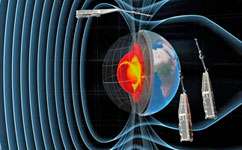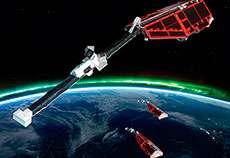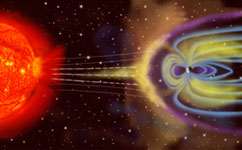Satellite Swarm prepares for take-off

Three satellites, each the size of a small car, will take off from the Plesetsk Cosmodrome in Russia on Friday.
As well as providing immediate improvements to navigation maps used in smartphones, the mission, organised by the European Space Agency, will monitor interactions between the Earth's magnetic field and the Sun's atmosphere.
This could help us to prepare for adverse space weather, which threatens to disturb vital communication and navigation systems on Earth.
'This exciting mission will help us solve some long-standing puzzles about the Earth's magnetic field, and hopefully discover a few new ones along the way,' says Dr Ciaran Beggan, of NERC's British Geological Survey.
'The benefits will be pretty much immediate, from new navigation maps, which are useful in smartphones, to a better picture of how the Sun interacts with Earth's magnetic field.'
The majority of Earth's magnetic field, sometimes referred to as its magnetosphere, originates from deep within its interior, stretching all the way out into space where it meets the solar wind – the constant stream of tiny charged particles released into space from the outer layers of the Sun.
But a number of processes in the rocks beneath our feet, the atmosphere, and the oceans also produce magnetism.

Two of the three identical Swarm satellites will orbit the Earth at a height of 450 kilometres, mapping the more subtle features of the Earth's magnetic field with more precision than ever before.
The third will operate in a higher orbit at around 530 kilometres, monitoring the interactions between Earth's magnetosphere and the atmosphere of its parent star.
In recent years, there have been growing concerns about the potential for solar storms to disturb vital communication and navigation systems on Earth.
The storms are caused as violent explosions in the Sun's atmosphere unleash massive bursts of solar wind out into space.
When they collide with our planet, they can disturb its magnetic field, playing havoc with key communication and navigation equipment.
They can also force the northern and southern lights – the stunning visual displays produced as the solar wind collides with the Earth's upper atmosphere – into lower latitudes.
During a particularly turbulent 48 hours in May this year, as solar activity neared a peak in its 11-year cycle, the northern lights could be seen as far south as East Sussex in England.

The swarm satellites, each carrying state-of-the-art magnetometers on a four-metre long arm, will attempt to shine a light on the effects of these solar blasts on the Earth's magnetic field.
This information will be vital to our understanding of their threat to key infrastructure, and could help us to prepare for adverse space weather in the future.
The mission will be the first time that the European Space Agency (ESA) has attempted to launch and control three satellites simultaneously.
It will mark the culmination of more than three years of careful preparation, including months of intensive training for mission control.
NERC's British Geological Survey, working alongside European colleagues, will process the magnetic data collected by the satellites. All of the data will then be made freely available from the ESA website.
Provided by PlanetEarth Online
This story is republished courtesy of Planet Earth online, a free, companion website to the award-winning magazine Planet Earth published and funded by the Natural Environment Research Council (NERC).





















